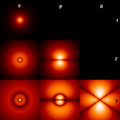Hydrogen atom
Hydrogen Atom
The Hydrogen atom is the simplest and most fundamental atom in the universe. It is composed of a single proton and a single electron, making it the lightest and most abundant element in the universe.
Structure[edit]
The hydrogen atom consists of a single positively charged proton and a single negatively charged electron. These two particles are held together by the electromagnetic force, which causes the electron to orbit the proton in a manner similar to how the Earth orbits the Sun.
Energy Levels[edit]
The energy levels of a hydrogen atom are quantized, meaning they can only take on certain discrete values. This is a result of the quantum mechanical nature of electrons. The energy levels are often represented by the principal quantum number n, which can take on any positive integer value. The energy of the electron in the nth energy level is given by the formula:
- E = -13.6 eV / n²
where E is the energy, eV is electron volts, and n is the principal quantum number.
Spectral Lines[edit]
When a hydrogen atom transitions from a higher energy level to a lower one, it emits a photon with a specific wavelength. These wavelengths correspond to the spectral lines of hydrogen, which are observed in the hydrogen spectrum. The wavelengths of these spectral lines can be calculated using the Rydberg formula.
Isotopes[edit]
There are three isotopes of hydrogen: protium, deuterium, and tritium. Protium is the most common isotope and consists of one proton and one electron. Deuterium has one proton, one neutron, and one electron, while tritium has one proton, two neutrons, and one electron.
Applications[edit]
Hydrogen atoms are crucial in many areas of science and technology. They are used in nuclear fusion reactions, which power the Sun and other stars. They are also used in spectroscopy to study the properties of other atoms and molecules.
See Also[edit]
Ad. Transform your life with W8MD's Budget GLP-1 injections from $75


W8MD offers a medical weight loss program to lose weight in Philadelphia. Our physician-supervised medical weight loss provides:
- Weight loss injections in NYC (generic and brand names):
- Zepbound / Mounjaro, Wegovy / Ozempic, Saxenda
- Most insurances accepted or discounted self-pay rates. We will obtain insurance prior authorizations if needed.
- Generic GLP1 weight loss injections from $75 for the starting dose.
- Also offer prescription weight loss medications including Phentermine, Qsymia, Diethylpropion, Contrave etc.
NYC weight loss doctor appointmentsNYC weight loss doctor appointments
Start your NYC weight loss journey today at our NYC medical weight loss and Philadelphia medical weight loss clinics.
- Call 718-946-5500 to lose weight in NYC or for medical weight loss in Philadelphia 215-676-2334.
- Tags:NYC medical weight loss, Philadelphia lose weight Zepbound NYC, Budget GLP1 weight loss injections, Wegovy Philadelphia, Wegovy NYC, Philadelphia medical weight loss, Brookly weight loss and Wegovy NYC
|
WikiMD's Wellness Encyclopedia |
| Let Food Be Thy Medicine Medicine Thy Food - Hippocrates |
Medical Disclaimer: WikiMD is not a substitute for professional medical advice. The information on WikiMD is provided as an information resource only, may be incorrect, outdated or misleading, and is not to be used or relied on for any diagnostic or treatment purposes. Please consult your health care provider before making any healthcare decisions or for guidance about a specific medical condition. WikiMD expressly disclaims responsibility, and shall have no liability, for any damages, loss, injury, or liability whatsoever suffered as a result of your reliance on the information contained in this site. By visiting this site you agree to the foregoing terms and conditions, which may from time to time be changed or supplemented by WikiMD. If you do not agree to the foregoing terms and conditions, you should not enter or use this site. See full disclaimer.
Credits:Most images are courtesy of Wikimedia commons, and templates, categories Wikipedia, licensed under CC BY SA or similar.
Translate this page: - East Asian
中文,
日本,
한국어,
South Asian
हिन्दी,
தமிழ்,
తెలుగు,
Urdu,
ಕನ್ನಡ,
Southeast Asian
Indonesian,
Vietnamese,
Thai,
မြန်မာဘာသာ,
বাংলা
European
español,
Deutsch,
français,
Greek,
português do Brasil,
polski,
română,
русский,
Nederlands,
norsk,
svenska,
suomi,
Italian
Middle Eastern & African
عربى,
Turkish,
Persian,
Hebrew,
Afrikaans,
isiZulu,
Kiswahili,
Other
Bulgarian,
Hungarian,
Czech,
Swedish,
മലയാളം,
मराठी,
ਪੰਜਾਬੀ,
ગુજરાતી,
Portuguese,
Ukrainian






